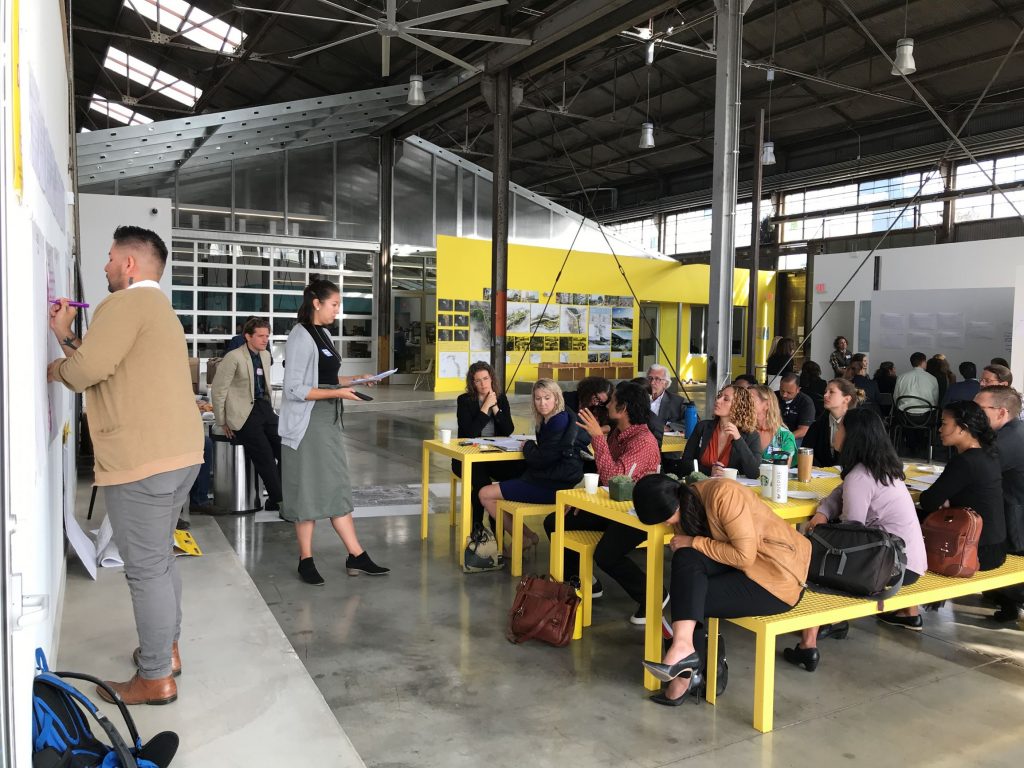UCLA convened public and private sector leaders across Los Angeles County to provide input on the topics of Landscapes and Ecosystems in L.A. County and their intersections with housing and land use, climate adaptation, water, and other cross-cutting sustainability topics.

The “Open Space, Built Environment & Biodiversity” workshop, held on October 23, 2018 at Studio-MLA in Boyle Heights, convened 71 attendees representing 47 public agencies, private companies, recreational and cultural facilities, and business and planning associations.
Laurel Hunt and Ari Simon from UCLA began the workshop with an overview of the stakeholder engagement process and the workshop. Gary Gero, L.A. County Chief Sustainability Officer, provided an overview of the Our County plan development process. Studio-MLA founder Mia Lehrer welcomed participants to the studio and spoke on the intersection of ecological planning in the region. Sean Kennedy from UCLA IoES’s California Center for Sustainable Communities (CCSC) followed with a presentation covering key background information, data, and regional findings related to topics such as protected lands, biodiversity, access to recreational facilities, urban development, gentrification, and climate change. Stakeholders in the room all received an accompanying briefing document outlining the information in the briefing presentation.
After the group presentations, workshop participants met in breakout groups to provide feedback on general Landscapes & Ecosystems draft goals that were included in the briefing and framed the discussion. Participants answered questions about what they feel biodiversity and habitat mean in the region, and what they see as its relationship to the built environment. This conversation spurred the group’s wider discussion about and reworking of the goals.
The second breakout session began with an activity where participants each selected one goal that aligned with their professional and personal experience and shared stories of successful implementations of related strategies. These one-on-one conversations led to a brainstorm amongst the full group of strategies that relate to the draft goals. Participants developed a list of Landscapes and Ecosystems-related sustainability strategies and dot-voted for ones they felt L.A. County should prioritize through the Plan.
The final breakout session had attendees pair off and come up with an idea for a public-private partnership opportunity that aligns open space, the built environment, and biodiversity.
Key Takeaways
- Stakeholders want to see L.A. County create partnerships with schools, places of worship, and cultural organizations to ensure better and more equitable ecological literacy amongst youth as well as for adults. This was broadly understood to include increased education as well as increased participation, with particular effort placed in communities with less geographic proximity to established ecological resources and/or with less financial resources.
- Commenting on the need for more people-oriented goals and strategies, stakeholders highlighted parks and open space facilities as opportunities for local hire as well as for local volunteerism. Maintenance and management emerged as key issues that require alternative approaches, and stakeholders want L.A. County to look towards local communities as part of the solution.
- Participants expressed the need to recognize places in and around the built environment as spaces of habitat. They noted that plazas, sidewalks, streets, and spaces in the public realm are highly accessible landscapes that can connect communities, meet climate adaptation needs, and help forge public-private partnerships.
- Throughout the discussions, participants pushed for enacting land use and transportation planning policies that ensure density and habitat connectivity. Stakeholders want to see the Plan strengthen L.A. County’s ability to prioritize infill development and stop threatening open spaces with new uses. They support development policies that value existing habitat in favor of replacements for lost natural resources. Participants also feel that the Plan must respond to homelessness and the housing crisis.
- Much of the feedback shared centered around supporting communities’ own visions and initiating deeper engagement. Participants want to see actions in the Plan that encourage residents to take the lead through their own land use decision-making, programming, and data collection. They feel L.A. County’s role is thus to offer community-led visions funding and feasibility. It was generally agreed that the draft Goals do not emphasize community engagement enough.
Comments on the key recommendations can be directed to sustainability@lacounty.gov.
Read more in the Open Space Public Private Workshop Summary
Download the Open Space Public Private Workshop Notes
Download the Open Space Public Private Workshop Presentation
Download the Our County Landscapes and Ecosystems Briefing
